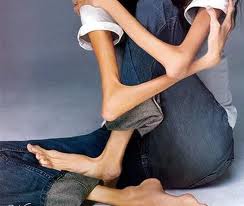Anorexia nervosa or simply known as Anorexia, psycho physiological eating disorder characterized by a rejection to sustain a good physical shape and there is an obsession of fear in attaining weight. An individual affected with anorexia nervosa is persistent in feeling of being hungry but try to refuse themselves with an intake of a very small amount of food. The usual caloric ingestion of a person affected with anorexia nervosa is 600 to 800 calories in a day. However, there are severe cases wherein they let themselves to be starved in able to achieve or maintain the image of being thin. Anorexia is considered as a dangerous mental ill health with a high occurrence of comorbidity and the highest fatality rate of psychiatric illness. A person inflicted with it happen to be obsessed on their body figure and weight, despite of how thin they are, they are still convinced that they are obese. It mostly affects girls during their adolescent period and young women but it can also happen in young boys and men. But anorexia nervosa frequently occur in women ten times more than in men.
The word anorexia nervosa was made by one of the medical doctor of Queen Victoria which is Sir William Gull. The word comes from Greek origin an and orexis meaning a lack of want or desire to eat.
Anorexia nervosa can be related to malnutrition which can be result to serious complications affecting every important part inside the body.
Does anorexia nervosa have signs and symptoms? If have what are they?
Anorexia nervosa may show a lot of signs and symptoms but not all are readily noticeable.
- There is a fast and remarkable weight loss.
- There is a presence of soft and delicate hair in the face and body or lanugo.
- Presence of too much fascination with fat and calories content.
- They may prepare food for others but not eat themselves.
- Keep on dieting in spite of being thin or severely underweight.
- There is an apprehension of becoming overweight or gaining weight.
- There is a habit of cutting food into small pieces, hide or throw-out foods.
- Person with anorexia usually uses ipecac syrup or laxatives after eating foods. They may also keep themselves to vomit to get free of the calories.
- They keep on a regular, exhausting physical exercise.
- Consider self of being overweight in spite of being told by other people that they are too thin.
- They commonly complain of feeling cold because of tremendously low blood pressure.
- They are frequently depressed and in weary state.
- A person with anorexia nervosa wanted to be alone most of the times. They stay away from their family and friends and become secretive.
- They usually wear a loose-fitting attire to hide the weight loss if they are already been deal with other people about their health or sometimes to hide of what they believe an unpleasant and obese body.
- There is a swelling of salivary glands due to extreme vomiting which may result to swollen cheeks.
- There is a swelling of abdomen.
What are the treatments for anorexia nervosa?
1.    Psychotherapy
 Psychotherapy is the most frequent use in treating anorexia nervosa. This type of therapy includes a financial commitment and time most especially if the affected persons are involved with other problems like depression, sexual abuse and others. It could be very useful not only in eating disorder but generally to the health and contentment of the person affected.
Psychotherapy is the most frequent use in treating anorexia nervosa. This type of therapy includes a financial commitment and time most especially if the affected persons are involved with other problems like depression, sexual abuse and others. It could be very useful not only in eating disorder but generally to the health and contentment of the person affected.
2.    Cognitive Behavioral Therapy
 Cognitive behavioral therapy is an attentive and a time-limited type of therapy that makes a person realize how their thoughts and harmful self-image can precisely affect their eating and unconstructive manners. This therapy is focusing in recognizing and at the same time changing the worthless beliefs, thoughts and attitudes which can cause and bring about the person in inhibiting self from eating. It is considered as a time-limited therapy because the person affected with anorexia will undergo a treatment only for a definite period of time with a particular purpose in mind. This can be done in an outpatient or once a week or inpatient setting.
Cognitive behavioral therapy is an attentive and a time-limited type of therapy that makes a person realize how their thoughts and harmful self-image can precisely affect their eating and unconstructive manners. This therapy is focusing in recognizing and at the same time changing the worthless beliefs, thoughts and attitudes which can cause and bring about the person in inhibiting self from eating. It is considered as a time-limited therapy because the person affected with anorexia will undergo a treatment only for a definite period of time with a particular purpose in mind. This can be done in an outpatient or once a week or inpatient setting.
3.    Family Therapy
 Family therapy facilitates a person affected with anorexia to observe and recognize the worthless role they have in the family. This therapy is usually done with the person affected with anorexia together with the whole family. But there are cases in some family therapy that the person with anorexia is being absent in the session for the family to fully understand the part they have as a support in recognizing the problem and looking for the treatment. There is a method known as a definite form of family therapy and it is the “Maudsley Method†wherein the parents are responsible in giving food to their anorexic teen for them to increase weight and to progress the eating pattern. The studies showed that this is effective in treating a person with anorexia in adolescent stage before it develops into a persistent manner.
Family therapy facilitates a person affected with anorexia to observe and recognize the worthless role they have in the family. This therapy is usually done with the person affected with anorexia together with the whole family. But there are cases in some family therapy that the person with anorexia is being absent in the session for the family to fully understand the part they have as a support in recognizing the problem and looking for the treatment. There is a method known as a definite form of family therapy and it is the “Maudsley Method†wherein the parents are responsible in giving food to their anorexic teen for them to increase weight and to progress the eating pattern. The studies showed that this is effective in treating a person with anorexia in adolescent stage before it develops into a persistent manner.
All these therapy will bring help, just ask or seek assistance from a medical expert of what therapy may benefit the person affected with anorexia nervosa.
